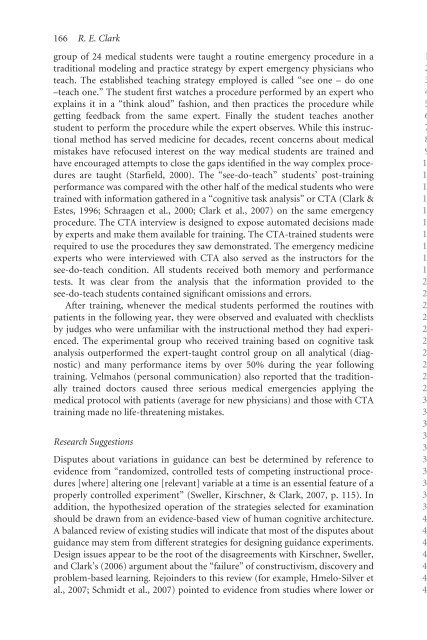9 How Much and What Type of Guidance is Optimal for Learning ...
9 How Much and What Type of Guidance is Optimal for Learning ...
9 How Much and What Type of Guidance is Optimal for Learning ...
Create successful ePaper yourself
Turn your PDF publications into a flip-book with our unique Google optimized e-Paper software.
166 R. E. Clarkgroup <strong>of</strong> 24 medical students were taught a routine emergency procedure in atraditional modeling <strong>and</strong> practice strategy by expert emergency physicians whoteach. The establ<strong>is</strong>hed teaching strategy employed <strong>is</strong> called “see one – do one–teach one.” The student first watches a procedure per<strong>for</strong>med by an expert whoexplains it in a “think aloud” fashion, <strong>and</strong> then practices the procedure whilegetting feedback from the same expert. Finally the student teaches anotherstudent to per<strong>for</strong>m the procedure while the expert observes. While th<strong>is</strong> instructionalmethod has served medicine <strong>for</strong> decades, recent concerns about medicalm<strong>is</strong>takes have refocused interest on the way medical students are trained <strong>and</strong>have encouraged attempts to close the gaps identified in the way complex proceduresare taught (Starfield, 2000). The “ see- do-teach” students’ post- trainingper<strong>for</strong>mance was compared with the other half <strong>of</strong> the medical students who weretrained with in<strong>for</strong>mation gathered in a “cognitive task analys<strong>is</strong>” or CTA (Clark &Estes, 1996; Schraagen et al., 2000; Clark et al., 2007) on the same emergencyprocedure. The CTA interview <strong>is</strong> designed to expose automated dec<strong>is</strong>ions madeby experts <strong>and</strong> make them available <strong>for</strong> training. The CTA- trained students wererequired to use the procedures they saw demonstrated. The emergency medicineexperts who were interviewed with CTA also served as the instructors <strong>for</strong> thesee- do-teach condition. All students received both memory <strong>and</strong> per<strong>for</strong>mancetests. It was clear from the analys<strong>is</strong> that the in<strong>for</strong>mation provided to thesee- do-teach students contained significant om<strong>is</strong>sions <strong>and</strong> errors.After training, whenever the medical students per<strong>for</strong>med the routines withpatients in the following year, they were observed <strong>and</strong> evaluated with checkl<strong>is</strong>tsby judges who were unfamiliar with the instructional method they had experienced.The experimental group who received training based on cognitive taskanalys<strong>is</strong> outper<strong>for</strong>med the expert- taught control group on all analytical (diagnostic)<strong>and</strong> many per<strong>for</strong>mance items by over 50% during the year followingtraining. Velmahos (personal communication) also reported that the traditionallytrained doctors caused three serious medical emergencies applying themedical protocol with patients (average <strong>for</strong> new physicians) <strong>and</strong> those with CTAtraining made no life- threatening m<strong>is</strong>takes.Research SuggestionsD<strong>is</strong>putes about variations in guidance can best be determined by reference toevidence from “r<strong>and</strong>omized, controlled tests <strong>of</strong> competing instructional procedures[where] altering one [relevant] variable at a time <strong>is</strong> an essential feature <strong>of</strong> aproperly controlled experiment” (Sweller, Kirschner, & Clark, 2007, p. 115). Inaddition, the hypothesized operation <strong>of</strong> the strategies selected <strong>for</strong> examinationshould be drawn from an evidence- based view <strong>of</strong> human cognitive architecture.A balanced review <strong>of</strong> ex<strong>is</strong>ting studies will indicate that most <strong>of</strong> the d<strong>is</strong>putes aboutguidance may stem from different strategies <strong>for</strong> designing guidance experiments.Design <strong>is</strong>sues appear to be the root <strong>of</strong> the d<strong>is</strong>agreements with Kirschner, Sweller,<strong>and</strong> Clark’s (2006) argument about the “failure” <strong>of</strong> constructiv<strong>is</strong>m, d<strong>is</strong>covery <strong>and</strong>problem- based learning. Rejoinders to th<strong>is</strong> review (<strong>for</strong> example, Hmelo- Silver etal., 2007; Schmidt et al., 2007) pointed to evidence from studies where lower or1234567891111111111222222222233333333334444444
















